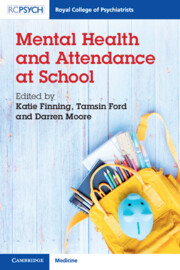Book contents
- Mental Health and Attendance at School
- Mental Health and Attendance at School
- Copyright page
- Contents
- Contributors
- Preface
- Acknowledgements
- Chapter 1 Mental Health and Attendance at School
- Chapter 2 School Attendance
- Chapter 3 Emotional Disorders and Attendance at School
- Chapter 4 Behavioural Disorders and Coping with School
- Chapter 5 Neurodevelopmental Disorders and Attendance at School
- Chapter 6 Educating a ‘New Me’ after an Acquired Brain Injury
- Chapter 7 School Influences on Attendance and Special Educational Needs
- Chapter 8 Supporting the Attendance of Vulnerable Children at School
- Chapter 9 School Attendance and Anxiety
- Chapter 10 Reflections on the Impact of Covid-19 on Children’s Education and Mental Health
- Index
- References
Chapter 10 - Reflections on the Impact of Covid-19 on Children’s Education and Mental Health
Published online by Cambridge University Press: 24 March 2022
- Mental Health and Attendance at School
- Mental Health and Attendance at School
- Copyright page
- Contents
- Contributors
- Preface
- Acknowledgements
- Chapter 1 Mental Health and Attendance at School
- Chapter 2 School Attendance
- Chapter 3 Emotional Disorders and Attendance at School
- Chapter 4 Behavioural Disorders and Coping with School
- Chapter 5 Neurodevelopmental Disorders and Attendance at School
- Chapter 6 Educating a ‘New Me’ after an Acquired Brain Injury
- Chapter 7 School Influences on Attendance and Special Educational Needs
- Chapter 8 Supporting the Attendance of Vulnerable Children at School
- Chapter 9 School Attendance and Anxiety
- Chapter 10 Reflections on the Impact of Covid-19 on Children’s Education and Mental Health
- Index
- References
Summary
At the time of writing, much of the world’s children and young people face continuing disruption to everyday life as their governments attempt to contain the Covid-19 pandemic. The scale and speed with which this particular virus swept the world and the global nature of disruption to education, social care and health services are fortunately highly unusual. There are both direct and indirect effects of infection on mental health, as well the reciprocal relationship between mental health and education, as discussed in previous chapters, which are likely to amplify the impacts of the pandemic and resulting restrictions on children and young people. This chapter reviews the evidence that has emerged to date.
- Type
- Chapter
- Information
- Mental Health and Attendance at School , pp. 181 - 191Publisher: Cambridge University PressPrint publication year: 2022
References
- 1
- Cited by

